|
Introduction
This section will talk about computer hardware
from the ground up. It is intended for beginners who do not know
what is in their computer and how it works. We will analyze and explain
the component parts of a computer. When you are done reading this
section, I hope most of the mystery about computer hardware should be
clarified.
Disclaimer
We cannot be held liable for any damages resulting from use of any
information in this section. This section is free, and comes with no
warranty of any kind. We have tried to make information in this section as
accurate as possible, but we cannot guarantee its accuracy.
Terms
Byte - A unit of data storage consisting of 8 bits.
Megabyte(Mb) - A unit of data storage consisting of about one million
bytes. This is normally used to refer to the amount of system memory or
floppy disk storage.
Megahertz(Mhz) - A unit of frequency. It is one million hertz. It
describes the clock frequency the microprocessor runs at. The larger the
number, generally the faster the microprocessor, but there are other
factors that affect microprocessor speed.
Gigabyte(Gb) - A unit of data storage consisting of about 1000
megabytes. This is normally used to refer to the amount of capacity a hard
drive has.
RAM - Random Access Memory
Inside the Case
Opening the case
Warning!!! Before deciding to open your computer case and touch or remove
any parts inside, you should be aware that your body can contain static
electricity that may be discharged to the circuits inside your computer.
A
static discharge can damage or ruin your computer. Therefore while
working on your machine you should always touch the frame of the machine
and have one part of your body in contact with it at all times. What
you are trying to prevent is a charge of static electricity sparking
between you and the parts you will be working on. Especially when working with the
microprocessor, memory, motherboard, or other plug in boards.
Warning! Hazard! Prior to opening your computer case, be sure it is
turned off and unplugged. 110 volts can cause injury or death!
Working on your computer while it is plugged in can damage or destroy it.
Notice I said you can cause damage to the computer. Unless you stick
something metal into the power supply (there is nothing in there you need
to worry about) you will not normally be harmed by the computer. If
you are wearing metal rings, necklaces, bracelets, or have other things dangling
in the machine you can damage it or hurt yourself.
Here is a good opportunity to be a
good example for anyone (our little ones) watching us to teach them the
proper way to work on electronics.
Besides you may need their help, if you get stuck and forget where a
part went and have to take it out and put it in again.
To open the computer case, depending on the type of case you have, follow one of the
these sets of instructions.
On some of our machines you press a clip under the front of the
machine.
on others
Remove one or two phillips head screws from the back
of your case that may hold one or more panels.
on others
Remove 4 or 5 screws in the back of the case. Be sure these screws hold
the case and not some other component like the power supply.
Slide the case foreword on its slots and remove it.
Remove the top panel and/or one or more necessary side panels.
Once you have opened the case, lay it on its side so you can look at
the inside components. You should see some variation of the following
picture.
Double Click on any of the pictures to see a larger view.
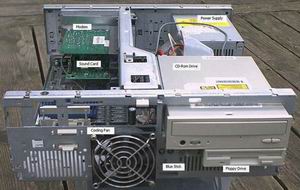
In the picture, the front of the computer is at the bottom and the rear
is at the top. At the front (bottom of the picture) are normally two metal
bays made to enclose hard drives, floppy drives, and CD-ROM drives. There
is a 5.25 inch and a 3.5 inch set of bays. Most hard drives will mount
into the smaller 3.5 inch bays with the CD-ROMS mounting in the 5.25 inch
bays. The hard floppy, and CD-ROM drives are mounted to their enclosures
with screws on their left and right sides. The power supply is on the top
right side of the picture which when the computer is in its normal
position is the top rear.
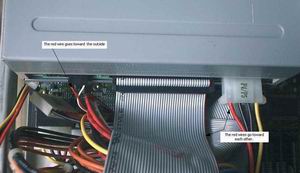
Cables
Between the hard, floppy, and CD-ROM drive bays you will see some thin
flat gray cables going to the floppy and hard drive connectors on the
motherboard. These are data cables used by the system to control
the drives and get and send data from and to them. On one side of the
gray cable should be a stripe (red or blue or a different color) going along the cable. This
stripe should
always be placed on the pin 1 side of the connector. You will need to look
closely at the connectors on your hard and floppy drives to determine
which is the pin 1 side or read your manual. On hard drives and most
CD-ROMs pin 1 is on the side closest to the power supply connector.
Some of
the data cables are keyed, so they are aren't put in backwards but others are not. It varies a little from
system to system.
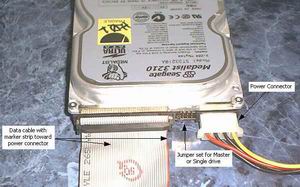
Cables running between the power supply are colored black, red, and
yellow. There is one going to each hard drive, floppy drive, CD-ROM drive
and any other drive the system is using such as a mass storage device. In
most of the machines the the power connector for the floppy drives is
smaller than the ones for the hard drive or the cd-roms. There is also a multicolored power supply cable with about 12 wires going
between the power supply and the motherboard. The wires are colored black,
red, yellow, orange, and blue this varies. The connector on this
cable should be keyed so it cannot be inserted the wrong way
The power supply
The power supply (are you ready for this)
supplies power for the computer. So it will
light up and make noise and you thought this would be hard. Most of
the power supplies are sealed so you can not stick your fingers in
it. Not
sticking your fingers in the power supply is a very good thing.
While the computer should not hurt you, the power supply can give quite a
shock. So leave it alone. There is nothing inside you can
repair. If it goes bad, you buy a new one (power supply, not
computer). The wherrrring noise you hear when you turn on your
computer is a fan in the power supply. This helps to keep the system
cool. Again do not poke anything in the fan holes to see if
it is working. If you do not hear the wherrring noise when you turn
it on, check for lights on the front panel of the machine. If there
are no lights, make sure the power is on in the outlet you are plugged
into. Someone may have turned off the wall switch. On some
machines, the fan sounds like a 747 taking off directly above your
head. While this can be annoying at least you know the fan is
working. The fans can not be repaired. The power supply will
have to be replaced. While most power supplies are attached to the
computer with 4 screws, the off and on switch has a number of different
ways of being attached and this should be left to some one with experience
in computer repair.
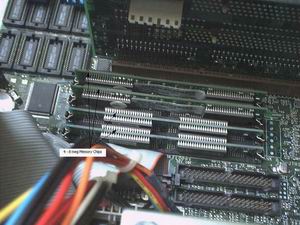
The Motherboard
The Memory Slots
The motherboard holds the
microprocessor, the memory, and several card slots. Most boards have
2, 3, or 4
memory slots, which may, depending on the size used, allow up or
beyond 1 Gb total system memory.
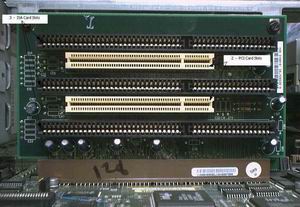
The Card Slots
The card slots are used to put additional cards such as video cards,
sound cards, internal modems, or network cards into. Some motherboards
today include video, network, and sound without the addition of a extra card. These
cards slots today are mostly PCI type card slots. When talking about cards
that are plugged into a PC you are talking about the expansion bus. The
expansion bus is a means of a microprocessor extending its communication
ability further into the outside world. It is a data exchange between add on cards and the microprocessor and the motherboard. There
have been several types of expansion buses.
ISA - Industry Standard Architecture. Used when the original 8088 8bit
microprocessor based personal computers were produced..
PCI - Peripheral Component Interconnect. The popular expansion bus of
choice. It is significantly faster than EISA.
AGP - Accelerated Graphics Port. This bus is developed for fast video
cards.
The current popular expansion bus is the PCI (Peripheral Component
Interconnect) bus for all cards except the graphics cards. For graphics
cards, the bus of choice is AGP. Most motherboards today have one AGP slot
and several PCI slots and some ISA slots. The ISA slots are larger
than the PCI ones. ISA slots are slower than PCI so if
possible use PCI expansion cards. Your expansion cards will plug into these card
slots. Be sure you get cards that match the available type of slots on
your motherboard.
Some microprocessor runs at 500Mhz and my memory runs at 100Mhz. Why?
As PC technology grew, eventually the access speed of the memory could
no longer keep pace with the increased speed of the microprocessors. At
this point, an I/O cache was placed on the microprocessor to be a buffer
between the external memory on the motherboard and the internal processor
registers. The memory was set to run at a different "side bus"
speed which is some fraction of the microprocessor speed. Therefore when
the speed of the microprocessor is set, it is set to some multiple of the
side bus speed. In the case of a 500Mhz processor and 100Mhz PC100 capable
memory, that multiple is 5. Sometimes this multiple and the sidebus
frequency is set using jumpers on the motherboard, or it may be set with
auto detection and the BIOS.
Chipset and BIOS
One issue that will affect the operation of the motherboard is the
chipset it uses and its BIOS it uses. The chipset is used to control the
interface between the microprocessor and most of the devices and memory on
the computer. The chipset used can have a significant affect on the
performance of your system as can the overall design of the motherboard.
Your system's BIOS is a computer program that allows your system to
begin running and provides a small library of functions that your system
will use to interface to various devices such as your hard drive,
keyboard, mouse and other items. The BIOS resides in a chip on the
motherboard called a ROM chip. Usually part of this ROM can be reset or re
programmed with updates. ROM that can be electrically re-written this way
is called "flash" ROM.
The Microprocessor
The microprocessor is the brain of your computer. It processes
instructions and communicates with outside devices, controlling most of
the operation of the computer. The microprocessor usually has a large heat
sink attached to it. Some microprocessors come in a package with a heat
sink and a fan included as a part of the package.
Microprocessors and Mounting
The mounting method refers to the type of connection the microprocessor
makes with the motherboard. The following table lists the various mounting
packages and some of the well known microprocessors that are mounted for
that package.
Socket 7 - AMD K5, K6, Intel Pentium 75-200Mhz, IBM
Socket 370 - Some Intel Celerons
Slot 1 - Intel Pentium II, Pentium III, Some Celeron 266-533
Slot II - Intel Xeon
Slot A - AMD Athlon
The Memory
Packaging
Memory chips are called DIPs which stands for Dual Inline Packages.
They are black chips with pins on both sides. Some say they look like
black bugs. To make memory installation easier than it was in the past,
these DIP chips were places on modules. There are two main module types
that memory comes packaged on today.
SIMM - Single Inline Memory Module. They may have DIPs on one or both
sides and will have 30 or 72 pins. Today, they normally are available in
the 72 pin size which supports a 32 bit data transfer between the
microprocessor and the memory.
DIMM - Double Inline Memory Module. The modules have 168 pins and
support a 64 bit data transfer between the microprocessor and the memory.
Synchronous Dynamic Access Memory (SDRAM) is the type of memory that is
found on DIMM packages. The term SDRAM describes the memory type, and the
term DIMM describes the package. These modules are available in 3.3 or 5
volt types and buffered or unbuffered memory. This allows four choices of
DIMM types. You should check your motherboard manual to determine the type
of memory required.
To install these packages, you press them into the socket on the
motherboard and latch them in with a plastic latch on both sides. Normally
as the memory module is pressed into place the latch will automatically
latch the module in place.
DRAM Access
DRAM memory is is accessed in chunks called cells. Every cell contains
a certain number of bits or bytes. A row, column scheme is used to specify
the section being accessed. The cells are arranged similar to the
following table.
ROW 1, COL 1 ROW 1, COL 2 ROW 1, COL 3
ROW 1, COL 4
ROW 2, COL 1 ROW 2, COL 2 ROW 2, COL 3
ROW 2, COL 4
ROW 3, COL 1 ROW 3, COL 2 ROW 3, COL 3
ROW 3, COL 4
ROW 4, COL 1 ROW 4, COL 2 ROW 4, COL 3
ROW 4, COL 4
When the DRAM is accessed, the row, then the column address is
specified. A page in memory is considered to be the memory available in
the row.
Types of DRAM
The term DRAM stands for Dynamic Random Access Memory. There are three
common types of DRAM today.
FPM DRAM - Fast Page Mode DRAM. When the first memory access is done,
the row or page of the memory is specified. Once this is done, FPO DRAM
allows any other row of memory to be accessed without specifying the row
number. This speeds up access time.
EDO DRAM - Extended Data Out DRAM. This works like FPO DRAM but it
holds the data valid even after strobe signals have gone inactive. This
allows the microprocessor to request memory, and it does not need to wait
for the memory to become valid. It can do other tasking, then come back
later to get the data.
SDRAM - Synchronized DRAM inputs and outputs its data synchronized to a
clock that runs at some fraction of the microprocessor speed. SDRAM is the
fastest of these three types of DRAM. There is a new SDRAM called DDR
(Double Data Rate) SDRAM which allows data reads on both the rising and
falling edge of the synchronized clock.
Cache Memory
Cache memory is special memory that operates much faster than SDRAM
memory. It is also more expensive. It would be impractical to use this
memory for the entire system both for reasons of expense and physical
board and bus channel design requirements. Cache memory lies between the
microprocessor and the system RAM. It is used as a buffer to reduce the
time of memory access. There are two levels to this memory called L1
(level 1) and L2 (level 2). The level 1 memory is a part of the
microprocessor, and the level 2 memory is just outside the microprocessor.
The Hard Drive(s)
Construction
Hard drives consist of a series of round metal plates called platters,
also called cylinders. They are coated with an electromagnetic material
which can support magnetic states that are capable of being electrically
altered. This means some type of electrical signal can alter the magnetic
polarization of various areas of the plates. The state of these polarized
areas can also be sensed. Each platter can hold large amounts of data.
There are several platters mounted on a hard drive. Between each platter
is a head which is used to sense and modify the states of the platter.
There are two heads on each platter.
Each platter has data stored on it in a specific pattern for read and
write access. The data is organized into tracks which are rings around the
platter. The distance the head moves into the platter will determine which
track is read. A sector is a section of data in the cylinder. Different
hard drives have different numbers of sectors, tracks, and platters.
Controller Interface Types
A hard drive is a mass storage device where your operation system is
installed along with many data files. There are two types of hard drives
with regard to the controller:
IDE - Integrated Drive Electronics. A controller based interface. If
your primary concern is low price with reasonable performance IDE is a
good choice. It is still the most popular controller interface because of
price.
SCSI - SCSI uses a separate bus hooked to the system bus using a host
adapter. It is a more expensive system than IDE, but is better built and
has a great deal of flexibility. There are several
types of SCSI interfaces, the primary difference being the width of the
data transfer (how many data bits are carried over the cable at a time).
The important item is to be sure you get compatible controllers with your
SCSI device such as your hard drive or CD-ROM drive.
Most hard drives have three characteristics of main importance for
performance.
Size - The size of the hard drive is expressed in terms of Gigabytes
which is roughly 1000 Megabytes.
Speed - The data output of a hard drive is primary limited by the
amount of time it takes for the electromagnetic head to reach the data at
specific locations on the drive. The primary factor of limitation is hard
drive rotation speed.
Reliability - The other performance factor that is worth considering is
reliability. This is expressed as mean time between failure (MTBF) The
higher the number, the better. Look for this specification on the
manufacturer's specification sheets for each product.
The CD-ROM
Originally
CD-ROMS were read only devices, but now read/write technology has been
developed.
Interface
Many CD-ROMs are interface to the computer using the ATAPI interface.
This is ATA Packet Interface which is a IDE interface. This is designed
for extra drives like CD-ROM's and tape drives that connect to an ATA
connector. The ATAPI interface is the standard interface for IDE
controlled CD-ROMS. If your CD-ROM uses an a ATAPI interface, it should be
supported by all available software. If you are using a SCSI controller,
you should probably use a SCSI CD-ROM. There are two primary types of
CD-ROMs today.
Read only and
Read and Write CD-ROM
These are primarily available as an internally mounted drive, but can
also be purchased as an external device. There are some CD-ROM drives that
interface through the USB port.
Speed
The primary performance concern of CD-ROM drives is their speed. Speeds
are expressed in terms of 1X, 2X, 4X, which is the number of times the
drive is than the standard CD-ROM reader. Of the read only type, speeds
have exceeded 50X.
The read/write type of CD-ROM speeds are expressed with three values.
They are read, write, and rewrite. Speeds of some of these devices are
read at 32X, write at 10X, and rewrite at 40X.
Other storage devices include:
DVD Drive - DVD stands for Digital Video Disk. Most DVD drives use the
ATAPI interface. They are available as internal or external devices. They are primarily
used for video storage but they can be used to hold audio and computer
data. DVD is categorized into DVD-Video and DVD-ROM devices. The DVD-ROM
device is for computer data storage.
Zip drives - A removable cartridge storage device that may be used to
store compressed data as a data back up method. A zip drive has between a
100Mb to 2G storage capacity. Cost is usually between $45 and $350.
More about DVD-ROM
There are five recordable versions of DVD-ROM. They can all can read
DVD-ROM and DVD-Video discs, but different type of disc is used by each
one for recording.
DVD-R/authoring - Can record data once.
DVD-R/general, - Can record data once. The capacity is 3.95 Gb or 4.7
Gb.
DVD-RAM - It is not compatible with current drives. It has a storage
capacity of 2.58 Gb It can be rewritten about 100,000 times The discs are
expected to hold data for 30 years or more.
DVD-RW - The capacity is 4.7 Gb. It can be rewritten about 1,000 times.
Monitor
Monitors are used to view your data on a computer. The characteristics
of your monitor are very important for your system performance since the
quality of your video will significantly affect your computing experience.
Components
Most monitors today consist of a picture tube and electronic control
circuitry which are used to transfer the signal to the screen. There are
some monitors that do not use a picture tube, but use electronics to
display information. These monitors are call flat screens and are more expensive
than regular monitors.
The primary and most expensive component in a standard monitor is its
picture tube. The most important characteristics of a monitor generally
refer to picture tube specifications although other circuitry can also be
important in providing picture clarity. A picture tube is basically a
large vacuum tube with a phosphorescent coating on the front of it. At the
back of the picture tube is a large electron gun ( actually 3 guns ) which
shoot(s) electrons onto the phosphorescent coating at the front of the
tube. When the electrons strike the coating, the coating glows. The
coating provides the primary colors which are red, blue, and green. These
component colors and their combinations can be used to make every other
possible color combination. There is other circuitry which works with the
gun to direct the electron gun to the proper color at the correct time,
and to direct the gun to the correct location on the screen depending on
the phase of the video signal that is being sent to the monitor. There is
magnetic circuitry which is used to bend the electron beam to strike the
appropriate area on the screen. This is referred to as deflection.
The yoke is an electromagnetic coil used to guide the beam to its
intended location. The color pattern on the phosphorous appears like the
three colored circles shown on the left side of the drawing below. There
are many of these color patterns on the screen. The closer the groups of
these three patterns are, the better the resolution of the monitor can be.
Monitor resolutions refers to the number of lines per inch that can be
seen on the screen. It is rated in vertical (up and down the screen) and
horizontal (left and right) terms.
Important Specifications
Some of the most important specifications on the monitor are:
Screen size - Expressed in inches, it is the approximate size of the
picture tube when measured from the lower left corner to the upper right
corner.
Spacing - Expressed in dot pitch. This is the description of how close
the three color patterns are spaced apart in the screen. The smaller
number, the better.
Maximum resolution at a specific frequency. This refers to the amount
of pixel resolution viewable on the screen at a specific scan frequency.
The higher the pixel resolution at a higher given scan frequency, the
better the monitor is. Generally look for 17 or 18 inch monitors that will
support at least 1024 x 768 pixel video resolution at 80Hz.
How dot pitch spacing can be deceiving
Different manufacturers and vendors rate dot pitch different ways.
There are actually three characteristics of dot pitch. They are:
Horizontal
Vertical
Diagonal
As you can see depending on how the dot pitch is measured, you may get
different numbers. You will need to carefully check manufacturer's
specifications to be sure the monitor you buy has the spacing you think it
has. Also read reviews on the monitors to see which ones have the best
performance.
Keyboard and Mouse
If you would really like to get any use on your computer, you would
probably like a keyboard and a mouse.
Keyboard
Keyboards can range in cost from about $10 to $100. I generally stay
with less expensive keyboards. There
are keyboards with a different feel or sound when key pressing is done.
Some people are particular about the feel and sound. If you are, you may
want to spend a little more for your keyboard. You may even want to buy it
from a retail store so you can test the feel of it. There are special
keyboards with extra functions on them for such things as surfing the
internet.
Mouse also called Pointing devices
The pointing device interface of choice is the PS/2 or the USB interface rather than the
older serial interface. Using a one of these interfaces will not require the use of
a serial port on your computer.
There are a quite a few types of pointing devices available.
The main choices are between:
Two or three buttons mice
Trackballs
Wireless
The choice of pointing devices depends on your preference and
whether the software you run on your computer will support it. If it does not support
it, it just means that you will
not be able to use some of the features on the pointing device. Many mice today have a sprocket wheel
in the center which will allow the user to scroll up and down documents on
the screen by turning the wheel. Also some mice are "ergonomic".
Depending on features and the quality of the internal roller ball and
mechanisms, a mouse can cost anywhere from $2 to $100. Or possibly you can
find one in your back yard, basement or a yard sale for free or foe a low
cost.
Should I assemble my own computer?
Below is a list of advantages and disadvantages of building your own
system.
Advantages:
I believe there is some price break in buying component parts through
discount dealers locally or on the web.
When you buy from some retail stores or buy a complete system, you do not get
to choose your own parts. In many cases, you may get a lower quality
motherboard, monitor, CD-ROM or other parts. When buying your own parts
you choose the best quality and features of parts for the money.
Disadvantages:
There is no dealer to stand behind the computer with a warranty or
service agreement if something goes wrong.
You have to put it together yourself and install your operating system
which can take several hours.
You must do more research, but that can be part of the fun.
Please be aware that a disadvantage listed above is there is no dealer
warranty. If you purchase a name brand quality computer component,
however, and it is installed properly, there is a manufacturer's warranty.
Depending on the product, it may be anywhere from 30 days to 3 years.
Another thing to consider is that many vendors have what are called
"bare bones" systems that you can buy the motherboard, with the
microprocessor, and memory already assembled, then you can buy your own
video, sound, and other cards along with hard drive and add it to your
system. Also you can buy your monitor separately from your main system and
still get a quality monitor of your choice.
What is OEM?
OEM stands for original equipment manufacturer. When you buy an OEM
part, it means you may not get any manuals, or software that accompanies
the product in a retail box. An OEM part is shipped as though it is sent
to a dealer who already knows how to install it and who would have the
software to install it. This may be significant depending on the part you
are purchasing. If you are purchasing a hard drive, floppy drive, or
CD-ROM drive it is not a serious concern. In this case it is better to get
the price break. If you buy an OEM disk drive, you can always get
installation instructions and any necessary drivers from the the service
and support section of the manufacturer's website.
If you are buying a sound card or video card, you may or may not want
to make your purchase an OEM purchase. For instance there may be special
software with a sound card that lets you write your own music. If this is
the case and you want the software, you should make the retail package
purchase. Also some video cards come with special game or other software
packages. In the case of a sound card or video card, buying OEM software
is a matter of preference.
When buying a microprocessor, always choose to buy a retail package.
This is because a retail package will come with any required hardware such
as a fan and heatsink. The warranty and return policy is also better. You
may choose to save money and buy the OEM package if you are confident that
you won't have any problems with your microprocessor.
Other items not listed above such as a motherboard have always come
with a manual and associated hardware so there is not an an issue of
buying OEM. The monitor is also sold as a standard package. The mouse,
keyboard and CD-ROM also do not discriminate between OEM and retail
packages.
|